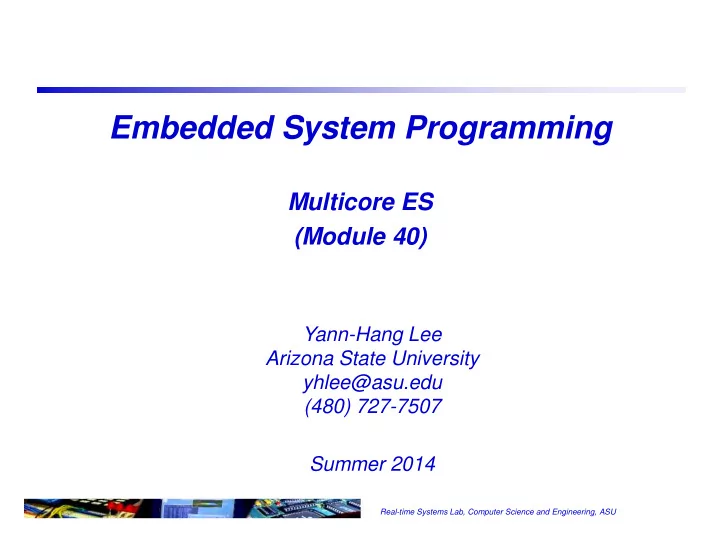

Embedded System Programming Multicore ES (Module 40) Yann-Hang Lee Arizona State University yhlee@asu.edu (480) 727-7507 Summer 2014 Real-time Systems Lab, Computer Science and Engineering, ASU
The Era of Multi-core Processors thread thread thread thread thread thread thread thread thread thread thread thread thread thread RTOS SMP-ready RTOS Single-Core processor Multi-Core processor Will the application run correctly a benign data race may become a true race scheduling anomaly How can we debug and monitor ES on multicore processors 1 Real-time Systems Lab, Computer Science and Engineering, ASU
Debugging Embedded Software In a 2002 NIST survey, an average bug found in post- product release takes 15.3 hours to fix. Cost of software development and product liability Testing process and software release time Finding bugs in multithreaded programs is difficult The bug and symptom are widely separated in space and time The system is nondeterministic The occurrence of potential errors may only be triggered after a long period of execution. Why is it challenging? Probe effect may alter program behavior Logged data could be enormous 2 Real-time Systems Lab, Computer Science and Engineering, ASU
Reproducible Execution Execution information must be logged for re-execution Overhead – ordering information or data, probe effect Static or dynamic (instrumentation at source or object code level) boundary of record/replay Thread 1 Thread 2 Thread 3 RTOS drivers & timer 3 Real-time Systems Lab, Computer Science and Engineering, ASU
Approach to Reproducible Execution Execution sequence → Partial order of synchronous events Preserve the order and apply the same IO events → reproducible execution send 1,1 T1 T2 T3 a send 1,1 recv 3,1 recv 3,1 send 3,2 send 3,2 program b send 1,2 sequence recv 2,1 recv 2,1 send 2,2 c recv 3,3 send 2,2 send 1,2 d recv 3,3 recv 3,3 recv 2,3 4 Real-time Systems Lab, Computer Science and Engineering, ASU
Existence of Probe Effect Any instrumentation of multi-threaded program execution may change the temporal behavior of program execution result in different ordering of execution events To detect event order variations caused by instrumentation simulate program execution based on execution time (w/o overhead), arrival events, synchronization and scheduling actions. program events from instrumented execution with execution time interrupts arrive at absolute time 5 Real-time Systems Lab, Computer Science and Engineering, ASU
Test Cases on Probe Effect (1) Total order is changed but with same partial order 6 Real-time Systems Lab, Computer Science and Engineering, ASU
Test Cases on Probe Effect (2) Different logical order leading to different execution path 7 Real-time Systems Lab, Computer Science and Engineering, ASU
Data Race Detectors A shared location is accessed by two different threads that are not ordered by happens-before relation at least one of the accesses is a write Many detectors for Java programs Static detectors – false alarms Dynamic detectors – need to instrument data accesses LockSet algorithms (Eraser) -- imprecise Happens-before algorithms – based on Lamport’s vector clock 8 Real-time Systems Lab, Computer Science and Engineering, ASU
Race Detector with Dynamic Granularity Vector clock based data race detector for C/C++ programs On top of FastTrack and using Intel PIN for dynamic instrumentation No need for a full VC on variables VC from O(n) to O(1) Share vector clock with neighboring memory locations Neighboring memory locations tend to be protected by the same lock (e.g. array, struct) 9 Real-time Systems Lab, Computer Science and Engineering, ASU
Performance Benchmark (1) Comparison with Valgrind DRD and Inspector XE Slowdown Memory Overhead Data race detected Inspector XE Inspector XE Inspector XE Bas granularity granularity granularity Dynamic Dynamic Dynamic Base Valgrind Valgrind Valgrind Benchmark e DRD DRD DRD Mem. Intel Intel Intel program time (MB) (sec) facesim 6.1 288 59 128 102 2.2 6.0 4.6 8909 31 8909 ferret 6.7 146 748 87 52 2.6 5.0 8.9 108 4 2 fluidanimate 2.0 248 -- 89 81 -- 12.4 2.2 -- 7 1 raytrace 9.5 170 42 17 27 1.9 4.1 2.0 16 0 13 dedup 7.7 2682 -- -- 85 -- -- 1.0 -- -- 0 streamcluster 3.8 30 66 108 137 4.2 17.5 3.7 1067 61 1079 ffmpeg 3.0 95 120 -- 109 2.6 -- 3.1 0 -- 1 pbzip2 5.7 67 64 99 39 2.9 8.6 3.4 0 0 0 hmmsearch 26.6 23 74 64 45 4.4 21.9 4.3 1 2 1 Average 168 85 75 3 11 4 10 Real-time Systems Lab, Computer Science and Engineering, ASU
Conclusion Continuous improvement for the replay mechanism Record network messages at a sniff server Checkpointing for long running systems Multicore To overcome potential problems caused by concurrency and scheduling Performance Correctness Real-time Multicore Application Concurrency & Synchronization 11 Real-time Systems Lab, Computer Science and Engineering, ASU
Recommend
More recommend